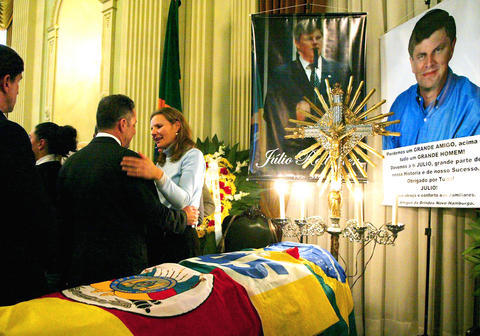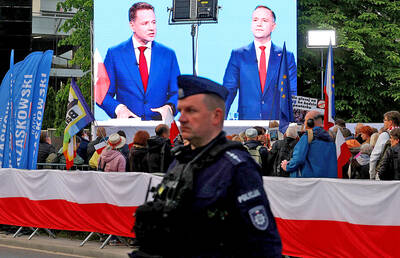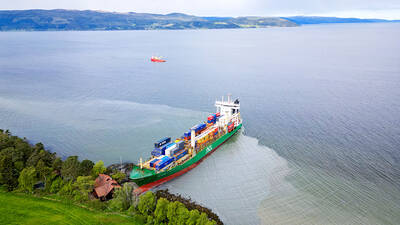Breaking three days of silence after the worst airline disaster in Brazilian history, President Luiz Inacio Lula da Silva went on television on Friday night to assure worried Brazilians that he had ordered immediate changes in the country's flawed civil aviation system.
The Brazilian government is "taking every step in our power to reduce the risk of new tragedies," da Silva said. He also urged Brazilians, who have had to cope with two major disasters in less than 10 months and who are calling for the government to step forward and take responsibility for the crisis, to remain "serene so as not to commit injustices."
Nearly 200 people died on Tuesday night when a TAM Airlines Airbus skidded off a short, slippery runway in Sao Paulo and exploded after plowing into an office building and gas station.

PHOTO: EPA
In September, 154 people were killed in a collision between two planes flying over the Amazon. Since then, Brazil has experienced several air traffic controller strikes, some near crashes, the breakdown of radar and other tracking systems, and widespread flight delays and cancellations.
After the crash on Tuesday, the International Federation of Air Traffic Controllers' Associations issued a statement warning that "air safety is currently compromised and is a danger to the traveling public" in Brazil because of government negligence.
In his brief remarks, da Silva acknowledged that Brazilian aviation is "experiencing difficulties," as he put it, and promised to modernize the air traffic control system, which had been the focus of the crisis before the crash on Tuesday.
Implicitly rejecting the international association's criticisms, he argued that Brazil had not fallen short in any aspect of international safety standards.
Da Silva spoke shortly after his chief of staff, Dilma Rousseff, announced what she called "short-term emergency measures" to cut congestion and "increase the degree of confidence" of passengers at Congonhas Airport, the site of the crash on Tuesday. Congonhas is the busiest airport not just in Brazil, but in all of South America, with more than 600 takeoffs and landings a day.
Under the government's new plan, Congonhas will cease within 60 days to be a hub for airlines and will in the future handle mostly shuttle passengers coming from Rio de Janeiro and other nonstop regional flights. Restrictions were also announced on charter flights to the airport as well as corporate and other private jets.
In addition, the government promised to build a new airport for the Sao Paulo metropolitan area, which has nearly 20 million residents. Government prosecutors are seeking an injunction to shut Congonhas altogether for safety reasons, a step that the head of the civil aviation agency says is "radical and impractical."
Da Silva has been widely criticized for showing a lack of leadership since the crash on Tuesday. Those complaints increased on Friday after one of his closest aides, Marco Aurelio Garcia, was filmed making an obscene gesture in response to a television report suggesting that a problem in the plane's turbine may have contributed to the crash.
Garcia said he made the gesture to express his "indignation" at what he said were attempts to use the disaster to score political points.
But that explanation only generated discord in Congress, whose members are mourning the death in the crash of one of their own, Julio Redecker, the minority leader of the lower house, who in his last speech last week asked, "Who will be the next victims of the chaos in the air?"

Polish presidential candidates offered different visions of Poland and its relations with Ukraine in a televised debate ahead of next week’s run-off, which remains on a knife-edge. During a head-to-head debate lasting two hours, centrist Warsaw Mayor Rafal Trzaskowski, from Polish Prime Minister Donald Tusk’s governing pro-European coalition, faced the Eurosceptic historian Karol Nawrocki, backed by the right-wing populist Law and Justice party (PiS). The two candidates, who qualified for the second round after coming in the top two places in the first vote on Sunday last week, clashed over Poland’s relations with Ukraine, EU policy and the track records of their

UNSCHEDULED VISIT: ‘It’s a very bulky new neighbor, but it will soon go away,’ said Johan Helberg of the 135m container ship that run aground near his house A man in Norway awoke early on Thursday to discover a huge container ship had run aground a stone’s throw from his fjord-side house — and he had slept through the commotion. For an as-yet unknown reason, the 135m NCL Salten sailed up onto shore just meters from Johan Helberg’s house in a fjord near Trondheim in central Norway. Helberg only discovered the unexpected visitor when a panicked neighbor who had rung his doorbell repeatedly to no avail gave up and called him on the phone. “The doorbell rang at a time of day when I don’t like to open,” Helberg told television

‘A THREAT’: Guyanese President Irfan Ali called on Venezuela to follow international court rulings over the region, whose border Guyana says was ratified back in 1899 Misael Zapara said he would vote in Venezuela’s first elections yesterday for the territory of Essequibo, despite living more than 100km away from the oil-rich Guyana-administered region. Both countries lay claim to Essequibo, which makes up two-thirds of Guyana’s territory and is home to 125,000 of its 800,000 citizens. Guyana has administered the region for decades. The centuries-old dispute has intensified since ExxonMobil discovered massive offshore oil deposits a decade ago, giving Guyana the largest crude oil reserves per capita in the world. Venezuela would elect a governor, eight National Assembly deputies and regional councilors in a newly created constituency for the 160,000

North Korea has detained another official over last week’s failed launch of a warship, which damaged the naval destroyer, state media reported yesterday. Pyongyang announced “a serious accident” at Wednesday last week’s launch ceremony, which crushed sections of the bottom of the new destroyer. North Korean leader Kim Jong-un called the mishap a “criminal act caused by absolute carelessness.” Ri Hyong-son, vice department director of the Munitions Industry Department of the Party Central Committee, was summoned and detained on Sunday, the Korean Central News Agency (KCNA) reported. He was “greatly responsible for the occurrence of the serious accident,” it said. Ri is the fourth person